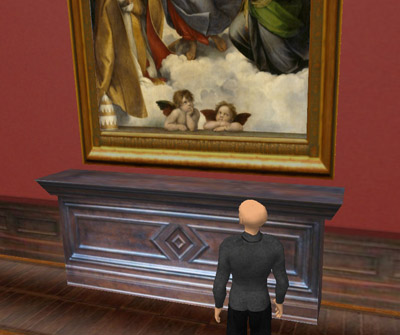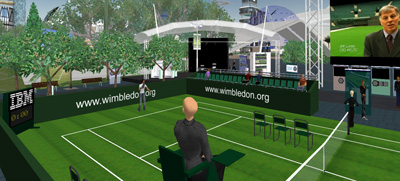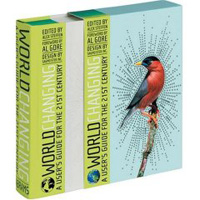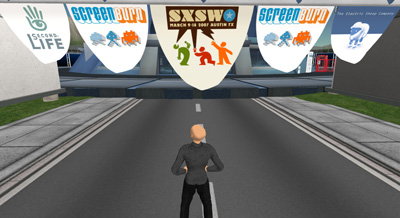Duplicate
Second Life has its first art museum that is a complete copy of a major real-world institution. The Dresden State Museum in Germany recently opened a sim that is pretty much the spitting image of its Old Masters Picture Gallery. (Teleport directly.) They claim that all 750 pieces in the collection are available.

It is impressive, for sure, and it definitely feels like a museum. Ceiling-to-floor wall-to-wall canvasses in darkish rooms with a single two-sided wooden bench in the middle. Wired claims that they’ve even modeled the museum’s trash bins. (What’s missing are the crowds, and that’s a good thing.)
But I have to wonder. Is this an added value to the museum experience? There are plenty of museums in Second Life (here’s a fave) and most all partake of an architecture that is suited to movement in SL (easy vertical movement, sparse use of walls, etc). It seems to me that older museums are hard enough to navigate in real life without imposing such constraints on virtual movement. How many Old Masters-type museums can you think of that don’t make you scale dozens of stairwells? This is discouraging in SL.
The larger point though is about choosing a medium. The web is actually very good at presenting images catalog-style like you’d encounter in a museum gallery. No crowds, good-to-great information, search, high-res zoom — all web based. It seems to me that a 3D museum space needs to afford more than just image viewing. I won’t say much more except to note that I suspect that some of the functionality you’d hope for in a virtual world-based museum is lacking in the Dresden gallery because of technical limitations of Second Life.
Still, a good project and one to keep an eye on. The museum outsourced this build to Anshe Chung and Co. so you know they are serious about it.
Of course, I’m not unconcerned with these matters. Bookmark this post to tell me how hypocritical I am in a year.
Wimbledon comes to Second Life (again)
One could argue that it was Wimbledon last year that really jump-started IBM’s involvement in virtual worlds. Before all the hype, before the “but I need a first life!” meme, before IBM committed itself to the space, a small crew of talented developers out of Hursley, England capitalized on IBM’s long relationship with Wimbledon* by creating a rudimentary centre court in Second Life. From there it’s really a blur.

Fast forward a year and the new Wimbledon build on one of the official IBM islands is a good showcase of how far we’ve come. Real-time shot trajectory plotting in 3D, weather plotting, scoreboards, video playback, a shop, and a backdrop for posing your avatar against actual photos from the All England club.
Eightbar has the full scoop, of course.
If you’ve got Second Life, have a visit.
[*] After The Hermitage, the Wimbledon webcasts of 1999 and 2000 were my next projects in IBM. There’s been nothing quite like the adrenalin of those days, coordinating live event coverage with outrageous traffic and no caching. (OK, almost nothing like it.)
Terraform this!: SXSW podcast available
Do you want to do your accounting inside a virtual world?
Terraforming the Internet panel, MP3 26.8MB.
Hack the planet: Spore and Worldchanging
The two most powerful presentations I saw at South by Southwest concerned vastly different topics — gaming and environmentalism — but their essence was the same. How to engineer a planet?
The first was Will Wright’s mile-a-minute discussion of interactive narrative and demo of the upcoming Spore (update: video) .Then, later that day was Alex Steffen’s captivating Worldchanging exploration of living for a sustainable future (udpate: podcast).
Spore of course is really Wright’s “SimUniverse,” starting you off in the protoplasmic goop as a unicellular creature in search of not dying and concluding, if evolution is kind, with you at the helm of a stable, interstellar civilization. Spore is, in short, a massive modeling tool for the complex systems that make up a world. It looks like a hell of a lot of fun.
Steffen’s presentation was about modeling a future world too, though in this case it is the one we’re currently living on. Where An Inconvenient Truth highlighted the problem, Steffen’s site, book, and organization work to demonstrate solutions. He is a powerful speaker. The audience was as spellbound as it was during the Spore demo and probably for the same reason: waiting raptly to find out how this particular world was going to turn out.
Both the game and the strategy for a sustainable Earth have to do with little things that have big consequences. In Spore this might be giving your creature asymmetrical appendages, something which may serve you well when foraging in nooks and crannies but which might turn out to be a liability in hand-to-hand combat or when piloting a spaceship. In Worldchanging, it might be car-sharing, for people who share a vehicle tend to be more efficient drivers since they have to plan their excursions. Both talks were essentially about sliding the scale on civilization and seeing what happens, what Steven Johnson calls The Long Zoom. (His recent book, The Ghost Map, focuses on the interplay of scale between the cholera microorganism and the urban patterns of 19th century London.)
Wright calls interactive narrative of this sort “filling in possibility space”. There’s always structure and constraint, but an element of free will allows for gameplay. You might argue the same goes for environmentalism. Natural resources, physics, and the human imagination are our constraints. We must merely fill in the possibility space, change the narrative for a happier ending.
Wright says that “the process of playing the game is the process of making assets for the game.” You could say the same thing about SimCity too, of course, but you could also say that about life. If life is a game — and in non-trivial ways, it is: a set of goal-directed actions to maximize returns — then we’ve got a rather tidy analogy on our hands. You don’t live in a static world; you make the world as you live.
Consider these quotes:
“One must dematerialize the extraneous stuff that gets in the way of the experiences we want.”
“Compact living in well-designed cities dematerializes transportation and infrastructure allowing access by proximity.”
“Many things are only garbage when they are in the wrong place.”
All from Steffen, all about eco-friendly living. But they’re absolutely relevant to Spore. Which isn’t to say that Spore is an in-your-face green manifesto. It isn’t. You might create a perfectly sustainable planet with oceans of methane. But in doing so you’ve foreclosed many possibility spaces suitable to human beings. Fun in a game, not so fun for carbon-based lifeforms.
Some other bits I found interesting in the Worldchanging session:
Car-sharing is an old idea (it just sounds 1970’s) made useful only through recent mapping and GPS technologies. ZipCar and iGo are successful because technology has finally made it easy for people to find a car when they need one.
Steffen asked how many in the audience owned power drills. Most hands went up. (This was a geekfest after all.) He then told us that the average power drill gets used for six to twenty minutes in its entire life — an epitome of unsustainable waste. What we want is the hole not the drill.
Measuring things changes the way you use them. The example he gave came from the UK where a test group had their energy meters moved inside the house. This act by itself reduced power consumption. When you see the meter you think about the meter and when you think about it you turn the lights off.
Why can’t we separate practical objects from objects that mean something to us? Your childhood teddy bear means something to you emotionally, where your washing machine most likely doesn’t. What if most practical objects were leased rather than owned? The effect would be greener production. If a cell phone manufacturer had to take the phone back at the end of its useful life the company would be far more likely to make it easy to recycle. (Steffen called computers — which nearly everyone in the audience had on their lap — an “environmental nightmare” because of their unrecyclability.)
It was interesting to me that some of the technologies found in the third world are the greenest: evaporative refrigeration, fog-catchers, rainwater recyclers, wired infrastructure leapfrogging.
The final bit of advice was to “green your geek.” Don’t stay up at night worrying about paper versus plastic. Rather focus on whatever you are really into (i.e., “your geek”) and try to change just that. Simple, potentially powerful.
In the end these two sessions about Spore and Worldchanging kinda merged in my head. To create a sustainable world you have to imagine what you want, then build it. Spore gives us a simulator; Worldchanging gives us an imperative.
Reminds me of the History Channel City of the Future design challenge. Much more on this soon!
As a sidenote, it’s been remarked that the panel-heavy structure of South by Southwest doesn’t allow for sustained exploration of an idea. I’m still a fan of the conversational tone of the panels, but in looking back on the week that was I admit that the three most powerful sessions I attended had a single speaker.
Worldbits
Some thought-bombs from SXSW. Sorry not to properly attribute quotes. Was typing too fast to look up. If not in quotes, it is just my observation and, thus, suspect.
- “Closed formats suck!” [applause] — Raph Koster, referring to Second Life and prims.
- People are pretty much salivating for a Google Earth-powered virtual world.
- “I want to see high-detail interiors.” — referring to the next step in Google Earth’s evolution.
- DIY data visualization sites like Many Eyes and Swivel could create lots of valuable overlays for Google Earth.
- John Tolva: “page-based vs. spatial internet” vs. Ben Cerveny: “document-based computing vs. relationship-based computing”.
- Justin Hall’s Passively Multiplayer Online Gaming.
- “Why do all the robots ‘live’ in Japan? Because the Japanese have an animist tradition and they have no problem that a non-living thing could be talking to them.”
- “Why is it that as soon as we get the ability to do anything we want in a virtual world that we immediately try to recreate ‘Menlo Park’? Painting sought a new direction when photography made realism easy.’ Why can’t we do that with virtual worlds?” This is one way of stating the oft-heard praise of the playful Wii versus the realist firepower of the PS3. Why must virtual worlds be photorealistic?
- “Online consumers are essentially non-player characters because their actions are so constrained.” LOVE that.
- Avatar psychology (from an audience response):
Do I contradict myself?
Very well then I contradict myself,
(I am large, I contain multitudes.)
— Walt Whitman, Song of Myself - “What is the role of the non-player character in a non-gaming world?” Um, how about a tour guide?
- You do know that Flickr, archetypal Web 2.0 site that it is, started as a game, right? The .gne extension you sometimes saw at Flickr stands for Game Neverending.
- Jamais Cascio asked: “Where is the 3D Wikipedia?”
Answer: “I think that might presuppose a taxonomy of everything in the world and that might be, you know, a challenge.” - “VRML wasn’t so useful for VR. It was too heavy. Online 3D spaces pull much more heavily from games. In the end, the commercial formats ended up being the good ones.” — Raph Koster
- “The number one form of user-created content is the screenshot.” — Raph Koster
- Word: “toyetic” — the toy-like enjoyability of something (Sketchup was the example).
- Word: “extimate” — opposite of intimate, but not the same as distant, referring to avatars — Jamais Cascio
- “It is far easier to make a Mii avatar than an SL avatar, ergo, there will be more Mii avatars. It is just that simple.” — Raph Koster
- “Humans actually relate to iconified individuals better than photorealistic individuals. 3D does not have to be photoreal.” — Raph Koster
- “We need some aesthetic honesty here. Mashups suck.” — Bruce Sterling
- Bruce Sterling describes the new global order, channeling Yochai Benkler:
- First World – the global market
- Second World – all forms of governance (local, regional, national)
- Third World – socially-motivated, commons-based peer production (e.g. Craigslist, Wikipedia)
- Fourth World – disorder (the largest and fastest-growing)
Universal format
So, I spent much of my time focusing on spatial tech, 3D worlds, metaversy stuff this SXSW season. There were so many good observations. I’ll sprinkle some in series a posts.
In the green room before our panel I was noting to Ben Batstone-Cunningham how odd it was that teens could not take their friend lists with them when they turn 18 and “graduate” from the teen grid to the main grid on Second Life. As a former Lindener, he said that this was entirely by design for security reasons (the two grids having no messaging interconnects) but that you could in fact bring your inventory with you to the new grid. But he also asked rather pointedly, which would you rather take, your list of friends or your actual things?
That’s not being crass. It is a statement about the non-techncial nature of people networks, the foundation of the success of any social world. You can’t export a personal relationship. Or, rather, you don’t need to. It is a universal format. It persists across platforms. Your app may facilitate the creation and maintenance of such relationships, but the relationships themselves move smoothly between any world. Watch as the Twittersphere shrinks post-SXSW. But the relationships — at least some of them — will persist.
There was much talk at SXSW about OpenID. When will x application support OpenID? So people are of course thinking about identity across worlds and this will help relationship networks bridge changing technologies.
But it does come back to people. Just like blogs, podcasts, and just about anything we seem to care about. This should be the focus first. Then technology.
Tags: socialnetworking
“Okay, I’m a little bummed. I didn’t learn anything.”
Best blog comment on my panel at SXSW this morning, above.
A good time and great discussion. Diverse panel, mosty sober audience (and panelists). Crappy interweb in the room though. Not sure it streamed into SL. Anyone know?
A few more thoughts here:
Note: lots of smart people at SXSW. Lots of good insights. Proficiency using microphones: not so much.
The truth hurts, don’t it?
Transcript (ish) on 3pointD here. More soon …
Digging in the virtual sands
It seems like just yesterday that the Eternal Egypt website debuted. In fact it has been over three years. Image content has steadily been added since launch, but the most popular experience on the site remains the Virtual Environments, 3D recreations of important places in Egyptian history. On the website these environments are panoramic slices of fully-modelled locales. In 2004 there was no good way to put a 3D world into a browser (still isn’t, come to that) so we rendered off static QTVR’s from dozens of vantage points. Compelling, but clearly a step down from the actual, navigable models.
Ah, but there’s more to that story. The Eternal Egypt Kiosk was developed as a freestanding unit that displays the full environments, arcade game-style. These kiosks have been donated to museums around the world and are quite a hit, especially as Egyptomania has resurged of late.
Here are some screenshots from the three environments: the Tomb of Tutankhamun, the Great Pyramids and Sphinx, and Luxor Temple.
With a joystick and a few buttons you move about the world learning as you go with the help of text and image overlays. It’s a lot like a MMORPG, without the MM or the G. And that’s the thing, the kiosk is great fun, but it is utterly devoid of others. Like you’re the last archaeologist living. Gee, if only someone were creating a truly collaborative cultural heritage MMO …
SXSW Screenburn panels in Second Life
The good folks at Electric Sheep will be streaming the SXSW Screenburn track of panels onto Sheep Island starting on Saturday. If you can’t join us in Austin, how about visiting there? Who knows if the kinks will be worked out by Saturday morning for the first panel (mine), but we’ll be in there if all’s well. Nothing like sniping at panelists from the metaverse.
Sheep Island this-a-way.
A bit more.
Head south, then southwest, then split the difference
SXSW Interactive is a little over a week away. I’m excited to be leading the first panel of the festival on virtual worlds called Terraforming the Internet. Even happier to announce the confirmed speakers.
Ben Batstone-Cunningham, Alt-Zoom Studios
Jan D’Alessandro, Meez
Eric Rice, Slackstreet Studios
Bill Victor, Halcyon Worlds
Talented, experienced, articulate, all of them. I am told they are mostly well-groomed. But don’t let grooming be an issue. If you’re in town for SXSW don’t let a Friday night hangover be an excuse not to come to our panel Saturday morning. Makes for a better discussion.
If you’ll be in town and want to meet up, drop a line.
And if you won’t be in town, why not? How can you pass up a conference with panels like Web Hacks: Good or Evil (or: Welcome to Web 2.666) and
Game Perverts: A Robot, a DS and a Dot Matrix Printer Menage a Trois?
Or for that matter film screenings for Hostel 2 and Helvetica and music performances by Girl Talk and Hoodoo Gurus. Something for everyone!
















